A Comprehensive Review of Strategies toward Efficient Flexible Piezoelectric Polymer Composites Based on BaTiO3 for Next-Generation Energy Harvesting
Abstract
:1. Introduction
2. Piezoelectricity
2.1. Discovery of Piezoelectricity and Materials
2.2. Working Principle and Electromechanical Coupling
2.3. Piezoelectric Coefficients
2.3.1. Piezoelectric Charge Coefficient
2.3.2. Piezoelectric Stress Coefficient
2.3.3. Piezoelectric Voltage Coefficient
2.3.4. The Piezoelectric Stiffness Coefficient
2.3.5. The Piezoelectric Coupling Coefficient “k”
2.3.6. Energy Flow of a Piezoelectric Generator
2.4. Piezoelectric Materials
3. BaTiO3 as Lead-Free Piezoelectric Material
3.1. Structure of BaTiO3
3.2. Synthesis Methods
3.2.1. The Conventional Solid-State Reaction
3.2.2. Chemical Methods for Barium Titanate Synthesis
- Sol–Gel Method
- Hydrothermal Method
- Co-Precipitation Method
- Polymeric Precursor Method
4. Flexible Piezoelectric Polymer Composite Nanogenerators Based on BaTiO3 Piezoceramic
5. Strategies for Efficiency Enhancement of Piezoelectric Polymer Composite Nanogenerators Based on BaTiO3
5.1. Modification of the Concentration of BaTiO3 Particles in Composites
5.2. Effect of Processing Methods
5.3. Doping
5.4. Surface Modification of BaTiO3
5.5. Addition of Conductive Particles/Ionic Gel
6. Selected Applications of BaTiO3-Based Piezoelectric Polymer Composite Nanogenerators
6.1. Self-Powered Devices for Internet of Things (IoT) Applications
6.2. Biomedical Applications
6.3. Automotive Applications
7. Novel Trends of BaTiO3-Based PENGs
8. Conclusions
Author Contributions
Funding
Data Availability Statement
Conflicts of Interest
References
- Khandelwal, G.; Maria Joseph Raj, N.P.; Kim, S.-J. Triboelectric Nanogenerator for Healthcare and Biomedical Applications. Nano Today 2020, 33, 100882. [Google Scholar] [CrossRef]
- Li, T.; Lee, P.S. Piezoelectric Energy Harvesting Technology: From Materials, Structures, to Applications. Small Struct. 2022, 3, 2100128. [Google Scholar] [CrossRef]
- Rathore, S.; Sharma, S.; Swain, B.P.; Ghadai, R.K. A Critical Review on Triboelectric Nanogenerator. IOP Conf. Ser. Mater. Sci. Eng. 2018, 377, 012186. [Google Scholar] [CrossRef]
- Carneiro, P.; Soares dos Santos, M.P.; Rodrigues, A.; Ferreira, J.A.F.; Simões, J.A.O.; Marques, A.T.; Kholkin, A.L. Electromagnetic Energy Harvesting Using Magnetic Levitation Architectures: A Review. Appl. Energy 2020, 260, 114191. [Google Scholar] [CrossRef]
- Ben Hassena, M.A.; Samaali, H.; Ouakad, H.M.; Najar, F. 2D Electrostatic Energy Harvesting Device Using a Single Shallow Arched Microbeam. Int. J. Non-Linear Mech. 2021, 132, 103700. [Google Scholar] [CrossRef]
- Safaei, M.; Sodano, H.A.; Anton, S.R. A Review of Energy Harvesting Using Piezoelectric Materials: State-of-the-Art a Decade Later (2008–2018). Smart Mater. Struct. 2019, 28, 113001. [Google Scholar] [CrossRef]
- Shrout, T.R.; Zhang, S.J. Lead-Free Piezoelectric Ceramics: Alternatives for PZT? J. Electroceram. 2007, 19, 113–126. [Google Scholar] [CrossRef]
- Ali, A.I.; Ahn, C.W.; Kim, Y.S. Enhancement of Piezoelectric and Ferroelectric Properties of BaTiO3 Ceramics by Aluminum Doping. Ceram. Int. 2013, 39, 6623–6629. [Google Scholar] [CrossRef]
- Liu, W.; Wang, J.; Ke, X.; Li, S. Large Piezoelectric Performance of Sn Doped BaTiO3 Ceramics Deviating from Quadruple Point. J. Alloys Compd. 2017, 712, 1–6. [Google Scholar] [CrossRef]
- Simon-Seveyrat, L.; Hajjaji, A.; Emziane, Y.; Guiffard, B.; Guyomar, D. Re-Investigation of Synthesis of BaTiO3 by Conventional Solid-State Reaction and Oxalate Coprecipitation Route for Piezoelectric Applications. Ceram. Int. 2007, 33, 35–40. [Google Scholar] [CrossRef]
- Farahani, A.; Zarei-Hanzaki, A.; Abedi, H.R.; Tayebi, L.; Mostafavi, E. Polylactic Acid Piezo-Biopolymers: Chemistry, Structural Evolution, Fabrication Methods, and Tissue Engineering Applications. J. Funct. Biomater. 2021, 12, 71. [Google Scholar] [CrossRef]
- Sappati, K.K.; Bhadra, S. Piezoelectric Polymer and Paper Substrates: A Review. Sensors 2018, 18, 3605. [Google Scholar] [CrossRef]
- Tichý, J.; Erhart, J.; Kittinger, E.; Přívratská, J. Fundamentals of Piezoelectric Sensorics: Mechanical, Dielectric, and Thermodynamical Properties of Piezoelectric Materials; Springer: Berlin/Heidelberg, Germany, 2010; ISBN 978-3-540-43966-0. [Google Scholar]
- Skoog, D.A.; Crouch, S.R.; Holler, F.J. Principles of Instrumental Analysis, 6th ed.; Thomson Brooks/Cole: Belmont, CA, USA, 2007; ISBN 978-0-495-01201-6. [Google Scholar]
- Moheimani, S.O.R.; Fleming, A.J. (Eds.) Fundamentals of Piezoelectricity. In Piezoelectric Transducers for Vibration Control and Damping; Advances in Industrial, Control; Springer: London, UK, 2006; pp. 9–35. ISBN 978-1-84628-332-1. [Google Scholar]
- Advances in Industrial Control. Available online: https://www.springer.com/series/1412 (accessed on 18 January 2024).
- Calavalle, F. Electrospun Polymer Nanofibers for Electromechanical Transduction Investigated by Scanning Probe Microscopy. Master’s Thesis, Università di Bologna, Corso di Studio in Fisica, Bologna, Italy, 2017. [Google Scholar]
- Kobayashi, J. Growing of Ferroelectric PbTiO3 Crystals. J. Appl. Phys. 1958, 29, 866–867. [Google Scholar] [CrossRef]
- Coursey, P.R.; Brand, K.G. Dielectric Constants of Some Titanates. Nature 1946, 157, 297–298. [Google Scholar] [CrossRef]
- Blattner, H.; Matthias, B. Investigations on barium titanate single crystals. Experientia 1947, 3, 148. [Google Scholar] [CrossRef]
- Scientific Method in Government. Nature 1945, 155, 463–466. [CrossRef]
- Zhang, D.; Yang, Y.; Rao, W.-F. Parameter Optimization for Printing Barium Titanate Piezoelectric Ceramics through Digital Light Processing. Micromachines 2023, 14, 1146. [Google Scholar] [CrossRef] [PubMed]
- Vijatović, M.M.; Bobić, J.D.; Stojanović, B.D. History and Challenges of Barium Titanate: Part II. Sci. Sinter. 2008, 40, 235–244. [Google Scholar] [CrossRef]
- Tsuji, K.; Ndayishimiye, A.; Lowum, S.; Floyd, R.; Wang, K.; Wetherington, M.; Maria, J.-P.; Randall, C.A. Single Step Densification of High Permittivity BaTiO3 Ceramics at 300 °C. J. Eur. Ceram. Soc. 2020, 40, 1280–1284. [Google Scholar] [CrossRef]
- Ogihara, H.; Randall, C.A.; Trolier-McKinstry, S. High-Energy Density Capacitors Utilizing 0.7 BaTiO3–0.3 BiScO3 Ceramics. J. Am. Ceram. Soc. 2009, 92, 1719–1724. [Google Scholar] [CrossRef]
- Zheng, P.; Zhang, J.L.; Tan, Y.Q.; Wang, C.L. Grain-Size Effects on Dielectric and Piezoelectric Properties of Poled BaTiO3 Ceramics. Acta Mater. 2012, 60, 5022–5030. [Google Scholar] [CrossRef]
- Haertling, G.H. Ferroelectric Ceramics: History and Technology. J. Am. Ceram. Soc. 1999, 82, 797–818. [Google Scholar] [CrossRef]
- Zhang, Y.; Jie, W.; Chen, P.; Liu, W.; Hao, J. Ferroelectric and Piezoelectric Effects on the Optical Process in Advanced Materials and Devices. Adv. Mater. 2018, 30, 1707007. [Google Scholar] [CrossRef] [PubMed]
- Tewatia, K.; Sharma, A.; Sharma, M.; Kumar, A. Factors Affecting Morphological and Electrical Properties of Barium Titanate: A Brief Review. Mater. Today Proc. 2021, 44, 4548–4556. [Google Scholar] [CrossRef]
- Brajesh, K.; Kalyani, A.K.; Ranjan, R. Ferroelectric Instabilities and Enhanced Piezoelectric Response in Ce Modified BaTiO3 Lead-Free Ceramics. Appl. Phys. Lett. 2015, 106, 012907. [Google Scholar] [CrossRef]
- Luo, S.; Tang, Z.; Yao, W.; Zhang, Z. Low-Temperature Combustion Synthesis and Characterization of Nanosized Tetragonal Barium Titanate Powders. Microelectron. Eng. 2003, 66, 147–152. [Google Scholar] [CrossRef]
- Megaw, H.D. Origin of Ferroelectricity in Barium Titanate and Other Perovskite-Type Crystals. Acta Cryst. 1952, 5, 739–749. [Google Scholar] [CrossRef]
- Banerjee, S.; Bairagi, S.; Wazed Ali, S. A Critical Review on Lead-Free Hybrid Materials for next Generation Piezoelectric Energy Harvesting and Conversion. Ceram. Int. 2021, 47, 16402–16421. [Google Scholar] [CrossRef]
- Akishige, Y.; Oomi, G.; Yamaoto, T.; Sawaguchi, E. Dielectric Properties of Ferroelectric Hexagonal BaTiO3. J. Phys. Soc. Jpn. 1989, 58, 930–939. [Google Scholar] [CrossRef]
- Liu, B.; Li, P.; Shen, B.; Zhai, J.; Zhang, Y.; Li, F.; Liu, X. Simultaneously Enhanced Piezoelectric Response and Piezoelectric Voltage Coefficient in Textured KNN-Based Ceramics. J. Am. Ceram. Soc. 2018, 101, 265–273. [Google Scholar] [CrossRef]
- Fang, R.; Zhou, Z.; Liang, R.; Dong, X. Significantly Improved Dielectric and Piezoelectric Properties by Defects in PbNb2O6-Based Piezoceramics. Ceram. Int. 2021, 47, 26942–26946. [Google Scholar] [CrossRef]
- Song, P.; Zhu, Z.; Yao, Z.; Hao, H.; Cao, M.; Liu, H. Piezoelectric Enhancement of 0.6Pb(Zr,Ti)O3–0.4Pb(Ni1/3Nb2/3)O3 Ceramics with Artificial MPB Engineering. J. Mater. Sci. Mater. Electron. 2024, 35, 58. [Google Scholar] [CrossRef]
- Yang, A.; Wang, C.-A.; Guo, R.; Huang, Y.; Nan, C.-W. Effects of Sintering Behavior on Microstructure and Piezoelectric Properties of Porous PZT Ceramics. Ceram. Int. 2010, 36, 549–554. [Google Scholar] [CrossRef]
- Xue, P.; Wu, H.; Lu, Y.; Zhu, X. Recent Progress in Molten Salt Synthesis of Low-Dimensional Perovskite Oxide Nanostructures, Structural Characterization, Properties, and Functional Applications: A Review. J. Mater. Sci. Technol. 2018, 34, 914–930. [Google Scholar] [CrossRef]
- Shen, Z.-Y.; Li, J.-F. Enhancement of Piezoelectric Constant d33 in BaTiO3 Ceramics Due to Nano-Domain Structure. J. Ceram. Soc. Jpn. 2010, 118, 940–943. [Google Scholar] [CrossRef]
- Simões, A.Z.; Cruz, M.P.; Ries, A.; Longo, E.; Varela, J.A.; Ramesh, R. Ferroelectric and Piezoelectric Properties of Bismuth Titanate Thin Films Grown on Different Bottom Electrodes by Soft Chemical Solution and Microwave Annealing. Mater. Res. Bull. 2007, 42, 975–981. [Google Scholar] [CrossRef]
- Yang, W.; Li, P.; Wu, S.; Li, F.; Shen, B.; Zhai, J. Coexistence of Excellent Piezoelectric Performance and Thermal Stability in KNN-Based Lead-Free Piezoelectric Ceramics. Ceram. Int. 2020, 46, 1390–1395. [Google Scholar] [CrossRef]
- Kimura, T.; Dong, Q.; Yin, S.; Hashimoto, T.; Sasaki, A.; Sato, T. Synthesis and Piezoelectric Properties of Li-Doped BaTiO3 by a Solvothermal Approach. J. Eur. Ceram. Soc. 2013, 33, 1009–1015. [Google Scholar] [CrossRef]
- Zhu, L.-F.; Zhang, B.-P.; Yang, W.-G. Enhancing Piezoelectric Coefficient d33 in LiF-Doped BaTiO3 Ceramics by Optimizing Excess Ba Content. Mater. Res. Bull. 2014, 52, 158–161. [Google Scholar] [CrossRef]
- Chen, M.; Xu, Z.; Chu, R.; Wang, Z.; Gao, S.; Yu, G.; Li, W.; Gong, S.; Li, G. Y2O3-Modified Ba(Ti0.96Sn0.04)O3 Ceramics with Improved Piezoelectricity and Raised Curie Temperature. Mater. Res. Bull. 2014, 59, 305–310. [Google Scholar] [CrossRef]
- Maurya, D.; Kumar, A.; Petkov, V.; Mahaney, J.E.; Katiyar, R.S.; Priya, S. Local Structure and Piezoelectric Instability in Lead-Free (1 − x)BaTiO3-xA(Cu1/3Nb2/3)O3 (A = Sr, Ca, Ba) Solid Solutions. RSC Adv. 2013, 4, 1283–1292. [Google Scholar] [CrossRef]
- Yan, S.; Zhao, M.; Wang, C.; Yu, D.; Wang, Y.; Wang, L.; Gai, Z.; Wang, C. Dielectric and Piezoelectric Properties of Bi12TiO20-xNa0.5Bi0.5TiO3 Polar Composite Ceramics. J. Alloys Compd. 2019, 774, 471–476. [Google Scholar] [CrossRef]
- Jaita, P.; Saenkam, K.; Rujijanagul, G. Improvements in Piezoelectric and Energy Harvesting Properties with a Slight Change in Depolarization Temperature in Modified BNKT Ceramics by a Simple Technique. RSC Adv. 2023, 13, 3743–3758. [Google Scholar] [CrossRef] [PubMed]
- Chen, Z.; Shui, A.; Lu, Z.; Liu, P. Piezoelectric and Dielectric Properties of (Bi0.5Na0.5)TiO3-Ba(Zr0.04Ti0.96)O3 Lead-Free Piezoelectric Ceramics. J. Ceram. Soc. Jpn. 2006, 114, 857–860. [Google Scholar] [CrossRef]
- Ghosh, M.; Rao, M.G. Growth Mechanism of ZnO Nanostructures for Ultra-High Piezoelectric d33 Coefficient. Mater. Express 2013, 3, 319–327. [Google Scholar] [CrossRef]
- Chen, X.; Hu, G.; Wu, W.; Yang, C.; Wang, X.; Fan, S. Large Piezoelectric Coefficient in Tb-Doped BiFeO3 Films. J. Am. Ceram. Soc. 2010, 93, 948–950. [Google Scholar] [CrossRef]
- Li, B.; Wang, X.; Li, L. Synthesis and Sintering Behavior of BaTiO3 Prepared by Different Chemical Methods. Mater. Chem. Phys. 2003, 78, 292–298. [Google Scholar] [CrossRef]
- Jiang, B.; Iocozzia, J.; Zhao, L.; Zhang, H.; Harn, Y.-W.; Chen, Y.; Lin, Z. Barium Titanate at the Nanoscale: Controlled Synthesis and Dielectric and Ferroelectric Properties. Chem. Soc. Rev. 2019, 48, 1194–1228. [Google Scholar] [CrossRef] [PubMed]
- Shao, S.; Zhang, J.; Zhang, Z.; Zheng, P.; Zhao, M.; Li, J.; Wang, C. High Piezoelectric Properties and Domain Configuration in BaTiO3 Ceramics Obtained through the Solid-State Reaction Route. J. Phys. D Appl. Phys. 2008, 41, 125408. [Google Scholar] [CrossRef]
- Pan, X.; Meng, B.; Yang, Q.; Ping, X.; Fang, C.; Ma, Z. Dielectric Properties of A and B-Site Doped BaTiO3-Based High-Entropy Ceramics Prepared by Fast Hot-Pressing Sintering. Ceram. Int. 2024, 50, 5806–5817. [Google Scholar] [CrossRef]
- Wang, L.; Liu, L.; Xue, D.; Kang, H.; Liu, C. Wet Routes of High Purity BaTiO3 Nanopowders. J. Alloys Compd. 2007, 440, 78–83. [Google Scholar] [CrossRef]
- Potdar, H.S.; Deshpande, S.B.; Date, S.K. Chemical Coprecipitation of Mixed (Ba+Ti) Oxalates Precursor Leading to BaTiO3 powders. Mater. Chem. Phys. 1999, 58, 121–127. [Google Scholar] [CrossRef]
- Cho, W.-S. Structural Evolution and Characterization of BaTiO3 Nanoparticles Synthesized from Polymeric Precursor. J. Phys. Chem. Solids 1998, 59, 659–666. [Google Scholar] [CrossRef]
- Almeida, G.N.; de Souza, R.N.; Lima, L.F.S.; Mohallem, N.D.S.; da Silva, E.P.; Silva, A.M.A. The Influence of the Synthesis Method on the Characteristics of BaTiO3. Materials 2023, 16, 3031. [Google Scholar] [CrossRef] [PubMed]
- Hench, L.L.; West, J.K. The Sol-Gel Process. Chem. Rev. 1990, 90, 33–72. [Google Scholar] [CrossRef]
- Li, W.; Xu, Z.; Chu, R.; Fu, P.; Hao, J. Structure and Electrical Properties of BaTiO3 Prepared by Sol–Gel Process. J. Alloys Compd. 2009, 482, 137–140. [Google Scholar] [CrossRef]
- Zhuang, Y.; Li, F.; Yang, G.; Xu, Z.; Li, J.; Fu, B.; Yang, Y.; Zhang, S. Fabrication and Piezoelectric Property of BaTiO3 Nanofibers. J. Am. Ceram. Soc. 2014, 97, 2725–2730. [Google Scholar] [CrossRef]
- Basantakumar Sharma, H.; Sarma, H.N.K.; Mansingh, A. Ferroelectric and Dielectric Properties of Sol-Gel Processed Barium Titanate Ceramics and Thin Films. J. Mater. Sci. 1999, 34, 1385–1390. [Google Scholar] [CrossRef]
- Gan, Y.X.; Jayatissa, A.H.; Yu, Z.; Chen, X.; Li, M. Hydrothermal Synthesis of Nanomaterials. J. Nanomater. 2020, 2020, e8917013. [Google Scholar] [CrossRef]
- Zhu, X.; Zhu, J.; Zhou, S.; Liu, Z.; Ming, N.; Hesse, D. BaTiO3 Nanocrystals: Hydrothermal Synthesis and Structural Characterization. J. Cryst. Growth 2005, 283, 553–562. [Google Scholar] [CrossRef]
- Kumar, D.; Kumar, S.; Kumar, S.; Thakur, N.; Shandilya, M. A Very Low Temperature Growth of BaTiO3 Nanoparticles by Sol-Hydrothermal Method. Phys. Status Solidi (A) 2022, 219, 2200238. [Google Scholar] [CrossRef]
- Yu, P.; Liu, W.; Gao, P.; Shao, T.; Zhao, S.; Han, Z.; Gu, X.; Zhang, J.; Wang, Y. Investigation on Synthesis of Tetragonal BaTiO3 Nanopowders by a New Wet Chemical Method. J. Mater. Sci. Mater. Electron. 2022, 33, 10828–10840. [Google Scholar] [CrossRef]
- Wang, L.; Su, Y.; Cao, J. Room Temperature Multiferroic Behavior of CoFe2O4–BaTiO3 Nanocomposites Prepared by the Co-Precipitation Method. J. Mater. Sci. Mater. Electron. 2023, 34, 1398. [Google Scholar] [CrossRef]
- Zhang, X.; Yue, J.; Zhao, Y.; Yan, Z.; Zhu, G.; Liu, L.; Xu, H.; Yu, A. Synthesis of Tetragonal BaTiO3 Nano-Particle via a Novel Tartaric Acid Co-Precipitation Process. Ceram. Int. 2021, 47, 7263–7267. [Google Scholar] [CrossRef]
- Suherman, B.; Nurosyid, F.; Khairuddin; Sandi, D.K.; Irian, Y. Impacts of Low Sintering Temperature on Microstructure, Atomic Bonds, and Dielectric Constant of Barium Titanate (BaTiO3) Prepared by Co-Precipitation Technique. J. Phys. Conf. Ser. 2022, 2190, 012006. [Google Scholar] [CrossRef]
- Cho, W.-S.; Hamada, E. Synthesis of Ultrafine BaTiO3 Particles from Polymeric Precursor: Their Structure and Surface Property. J. Alloys Compd. 1998, 266, 118–122. [Google Scholar] [CrossRef]
- Mi, L.; Zhang, Q.; Wang, H.; Wu, Z.; Guo, Y.; Li, Y.; Xiong, X.; Liu, K.; Fu, W.; Ma, Y.; et al. Synthesis of BaTiO3 Nanoparticles by Sol-Gel Assisted Solid Phase Method and Its Formation Mechanism and Photocatalytic Activity. Ceram. Int. 2020, 46, 10619–10633. [Google Scholar] [CrossRef]
- Jiao, H.; Zhao, K.; Ma, L.; Tang, Y.; Liu, X.; Bian, T. Preparation and Characterization of BaTiO3/HA Nanocomposite Materials by Hydrothermal Synthesis. J. Alloys Compd. 2017, 693, 221–225. [Google Scholar] [CrossRef]
- Vijayalakshmi, R. Synthesis and Characterization of Cubic BaTiO3 Nanorods via Facile Hydrothermal Method and Their Optical Properties. Dig. J. Nanomater. Biostruct. 2010, 5, 511–517. [Google Scholar]
- García-Hernández, M.; Chadeyron, G.; Boyer, D.; García-Murillo, A.; Carrillo-Romo, F.; Mahiou, R. Hydrothermal Synthesis and Characterization of Europium-Doped Barium Titanate Nanocrystallites. Nano-Micro Lett. 2013, 5, 57–65. [Google Scholar] [CrossRef]
- Xue, K.; Jiang, Y.; Mofarah, S.S.; Doustkhah, E.; Zhou, S.; Zheng, X.; Huang, S.; Wang, D.; Sorrell, C.C.; Koshy, P. Composition-Driven Morphological Evolution of BaTiO3 Nanowires for Efficient Piezocatalytic Hydrogen Production. Chemosphere 2023, 338, 139337. [Google Scholar] [CrossRef] [PubMed]
- Lee, W.W.; Chung, W.-H.; Huang, W.-S.; Lin, W.-C.; Lin, W.-Y.; Jiang, Y.-R.; Chen, C.-C. Photocatalytic Activity and Mechanism of Nano-Cubic Barium Titanate Prepared by a Hydrothermal Method. J. Taiwan Inst. Chem. Eng. 2013, 44, 660–669. [Google Scholar] [CrossRef]
- Gajović, A.; Pleština, J.V.; Žagar, K.; Plodinec, M.; Šturm, S.; Čeh, M. Temperature-Dependent Raman Spectroscopy of BaTiO3 Nanorods Synthesized by Using a Template-Assisted Sol–Gel Procedure. J. Raman Spectrosc. 2013, 44, 412–420. [Google Scholar] [CrossRef]
- Shangguan, M.; Zhang, X.; Wang, C.; Zhao, Y.; Zhu, G.; Liu, L.; Xu, H. Synthesis and Performance of Tetragonal BaTiO3 Fine Powders via a Facile Tartaric Acid Assisted Method. J. Eur. Ceram. Soc. 2023, 43, 6883–6892. [Google Scholar] [CrossRef]
- Mahalakshmi, S.; Mayandi, J.; Sagadevan, S.; Ragavendran, V.; Manikandan, K.; Arumugam, S.; Pearce, J.M.; Venkatachalapathy, V. Enriched Second-Harmonic Generation in Meta-Phase Barium Titanate Nanostructures Synthesized by Sol-Gel Hydrothermal Method. J. Alloys Compd. 2023, 936, 168171. [Google Scholar] [CrossRef]
- Song, E.; Kim, D.H.; Jeong, E.J.; Choi, M.; Kim, Y.; Jung, H.J.; Choi, M.Y. Effects of Particle Size and Polymorph Type of TiO2 on the Properties of BaTiO3 Nanopowder Prepared by Solid-State Reaction. Environ. Res. 2021, 202, 111668. [Google Scholar] [CrossRef]
- Hennings, D.F.K.; Schreinemacher, B.S.; Schreinemacher, H. Solid-State Preparation of BaTiO3-Based Dielectrics, Using Ultrafine Raw Materials. J. Am. Ceram. Soc. 2001, 84, 2777–2782. [Google Scholar] [CrossRef]
- Wang, X.; Xiao, C.; Liu, H.; Huang, Q.; Fu, H. Fabrication and Properties of PVDF and PVDF-HFP Microfiltration Membranes. J. Appl. Polym. Sci. 2018, 135, 46711. [Google Scholar] [CrossRef]
- Mishra, S.; Unnikrishnan, L.; Nayak, S.K.; Mohanty, S. Advances in Piezoelectric Polymer Composites for Energy Harvesting Applications: A Systematic Review. Macromol. Mater. Eng. 2019, 304, 1800463. [Google Scholar] [CrossRef]
- Zhang, G.; Liao, Q.; Zhang, Z.; Liang, Q.; Zhao, Y.; Zheng, X.; Zhang, Y. Novel Piezoelectric Paper-Based Flexible Nanogenerators Composed of BaTiO3 Nanoparticles and Bacterial Cellulose. Adv. Sci. 2016, 3, 1500257. [Google Scholar] [CrossRef]
- Su, H.; Wang, X.; Li, C.; Wang, Z.; Wu, Y.; Zhang, J.; Zhang, Y.; Zhao, C.; Wu, J.; Zheng, H. Enhanced Energy Harvesting Ability of Polydimethylsiloxane-BaTiO3-Based Flexible Piezoelectric Nanogenerator for Tactile Imitation Application. Nano Energy 2021, 83, 105809. [Google Scholar] [CrossRef]
- Lin, Z.-H.; Yang, Y.; Wu, J.M.; Liu, Y.; Zhang, F.; Wang, Z.L. BaTiO3 Nanotubes-Based Flexible and Transparent Nanogenerators. J. Phys. Chem. Lett. 2012, 3, 3599–3604. [Google Scholar] [CrossRef]
- Tsege, E.L.; Kim, G.H.; Annapureddy, V.; Kim, B.; Kim, H.-K.; Hwang, Y.-H. A Flexible Lead-Free Piezoelectric Nanogenerator Based on Vertically Aligned BaTiO3 Nanotube Arrays on a Ti-Mesh Substrate. RSC Adv. 2016, 6, 81426–81435. [Google Scholar] [CrossRef]
- Alluri, N.R.; Saravanakumar, B.; Kim, S.-J. Flexible, Hybrid Piezoelectric Film (BaTi(1 − x)ZrxO3)/PVDF Nanogenerator as a Self-Powered Fluid Velocity Sensor. ACS Appl. Mater. Interfaces 2015, 7, 9831–9840. [Google Scholar] [CrossRef] [PubMed]
- Jeder, K.; Bouhamed, A.; Nouri, H.; Abdelmoula, N.; Jöhrmann, N.; Wunderle, B.; Khemakhem, H.; Kanoun, O. Enhancement of the Performance of Flexible Lead-Free Nanogenerators by Doping in BaTiO3 Nanoparticles. Energy 2022, 261, 125169. [Google Scholar] [CrossRef]
- Bouhamed, A.; Jöhrmann, N.; Naifar, S.; Böhm, B.; Hellwig, O.; Wunderle, B.; Kanoun, O. Collaborative Filler Network for Enhancing the Performance of BaTiO3/PDMS Flexible Piezoelectric Polymer Composite Nanogenerators. Sensors 2022, 22, 4181. [Google Scholar] [CrossRef] [PubMed]
- Ayadi, M.D.; Gassara Hammami, D.; Naifar, S.; Bouhamed, A.; Bradai, C.; Kanoun, O. Electromechanical Performance and Figure of Merit Optimization for Flexible Lead-Free PDMS–BaTiO3 Piezocomposites. ACS Omega 2024, 9, 28951–28960. [Google Scholar] [CrossRef] [PubMed]
- Meisak, D.; Kinka, M.; Plyushch, A.; Macutkevič, J.; Zarkov, A.; Schaefer, S.; Selskis, A.; Samulionis, V.; Kuzhir, P.; Banys, J.; et al. Piezoelectric Nanogenerators Based On BaTiO3/PDMS Composites for High-Frequency Applications. ACS Omega 2023, 8, 13911–13919. [Google Scholar] [CrossRef] [PubMed]
- Nunes-Pereira, J.; Sencadas, V.; Correia, V.; Cardoso, V.F.; Han, W.; Rocha, J.G.; Lanceros-Méndez, S. Energy Harvesting Performance of BaTiO3/Poly(Vinylidene Fluoride–Trifluoroethylene) Spin Coated Nanocomposites. Compos. Part B Eng. 2015, 72, 130–136. [Google Scholar] [CrossRef]
- Athira, B.S.; George, A.; Vaishna Priya, K.; Hareesh, U.S.; Gowd, E.B.; Surendran, K.P.; Chandran, A. High-Performance Flexible Piezoelectric Nanogenerator Based on Electrospun PVDF-BaTiO3 Nanofibers for Self-Powered Vibration Sensing Applications. ACS Appl. Mater. Interfaces 2022, 14, 44239–44250. [Google Scholar] [CrossRef]
- Kubin, M.; Makreski, P.; Zanoni, M.; Gasperini, L.; Selleri, G.; Fabiani, D.; Gualandi, C.; Bužarovska, A. Effects of Nano-Sized BaTiO3 on Microstructural, Thermal, Mechanical and Piezoelectric Behavior of Electrospun PVDF/BaTiO3 Nanocomposite Mats. Polym. Test. 2023, 126, 108158. [Google Scholar] [CrossRef]
- Xue, J.; Wu, T.; Dai, Y.; Xia, Y. Electrospinning and Electrospun Nanofibers: Methods, Materials, and Applications. Chem. Rev. 2019, 119, 5298–5415. [Google Scholar] [CrossRef]
- Korkmaz, S.; Kariper, I.A. BaTiO3-Based Nanogenerators: Fundamentals and Current Status. J. Electroceram. 2022, 48, 8–34. [Google Scholar] [CrossRef]
- Jeder, K.; Bouhamed, A.; Khemakhem, H.; Kanoun, O. Effect of Sonication Amplitude on Piezoelectric and Mechanical Properties of BCZT/PVDF-HFP Composite. In Proceedings of the 2022 19th International Multi-Conference on Systems, Signals & Devices (SSD), Setif, Algeria, 6–10 May 2022; pp. 1300–1306. [Google Scholar]
- Güçlü, H.; Kasım, H.; Yazici, M. Investigation of the Optimum Vibration Energy Harvesting Performance of Electrospun PVDF/BaTiO3 Nanogenerator. J. Compos. Mater. 2023, 57, 409–424. [Google Scholar] [CrossRef]
- Bouhamed, A.; Binyu, Q.; Böhm, B.; Jöhrmann, N.; Behme, N.; Goedel, W.A.; Wunderle, B.; Hellwig, O.; Kanoun, O. A Hybrid Piezoelectric Composite Flexible Film Based on PVDF-HFP for Boosting Power Generation. Compos. Sci. Technol. 2021, 208, 108769. [Google Scholar] [CrossRef]
- Misaaoui, S.; Bouhamed, A.; Khemakhem, H.; Kanoun, O. Influence of Polar Solvents on Lead Free BCZT Based Flexible Nanogenerators Performance. In Proceedings of the 2022 International Workshop on Impedance Spectroscopy (IWIS), Chemnitz, Germany, 27–30 September 2022; pp. 99–101. [Google Scholar] [CrossRef]
- Gao, J.; Xue, D.; Bao, H.; Zhang, L.; Zhou, C.; Liu, W.; Chen, W.; Ren, X. Aging-Induced Two-Step Ferroelectric-to-Paraelectric Transition in Acceptor-Doped Ferroelectrics. Appl. Phys. Lett. 2010, 96, 082906. [Google Scholar] [CrossRef]
- Köferstein, R.; Jäger, L.; Zenkner, M.; Ebbinghaus, S.G. Phase Transition and Dielectric Properties of BaTiO3 Ceramics Containing 10 mol% BaGeO3. Mater. Chem. Phys. 2010, 119, 118–122. [Google Scholar] [CrossRef]
- Borkar, H.; Rao, V.; Tomar, M.; Gupta, V.; Kumar, A. Near Room Temperature Bismuth and Lithium Co-Substituted BaTiO3 Relaxor Ferroelectrics Family. J. Alloys Compd. 2018, 737, 821–828. [Google Scholar] [CrossRef]
- Ben, L.; Sinclair, D.C. Anomalous Curie Temperature Behavior of A-Site Gd-Doped BaTiO3 Ceramics: The Influence of Strain. Appl. Phys. Lett. 2011, 98, 092907. [Google Scholar] [CrossRef]
- Tang, B.; Zhang, S.-R.; Yuan, Y.; Yang, L.-B.; Zhou, X.-H. Influence of Tetragonality and Secondary Phase on the Curie Temperature for Barium Titanate Ceramics. J. Mater. Sci. Mater. Electron. 2008, 19, 1109–1113. [Google Scholar] [CrossRef]
- Wu, D.; Fang, B.; Du, Q.; Ding, J. Preparation and Properties of La and K Co-Doped BaTiO3 Lead-Free Piezoelectric Ceramics. Ferroelectrics 2012, 432, 81–91. [Google Scholar] [CrossRef]
- Lou, Q.; Shi, X.; Ruan, X.; Zeng, J.; Man, Z.; Zheng, L.; Park, C.H.; Li, G. Ferroelectric Properties of Li-Doped BaTiO3 Ceramics. J. Am. Ceram. Soc. 2018, 101, 3597–3604. [Google Scholar] [CrossRef]
- Missaoui, D.; Bouhamed, A.; Jeder, K.; Njeh, A.; Donner, W.; Kassiba, A.H.; Kanoun, O. Design and Characterization of a PDMS/BCT/Multiwalled Carbon Nanotube Nanocomposite as a Piezoelectric Energy Harvester. ACS Appl. Electron. Mater. 2023, 6, 183–193. [Google Scholar] [CrossRef]
- Ayed, A.B.; Bouhamed, A.; Nouri, H.; Abdelmoula, N.; Khemakhem, H.; Kanoun, O. Robust and Flexible Piezoelectric Lead-Free Zn-BCZT/PVDF-HFP Nanogenerators for Wearable Energy Harvesting. ACS Appl. Electron. Mater. 2023, 5, 4282–4295. [Google Scholar] [CrossRef]
- Sarra, M.; Ayda, B.; Hamadi, K.; Olfa, K. Enhancing Electrical and Mechanical by Sn Doping in BCZT for High Performance Nanogenerators. In Proceedings of the 2022 19th International Multi-Conference on Systems, Signals & Devices (SSD), Setif, Algeria, 6–10 May 2022; pp. 561–565. [Google Scholar]
- Ataabadi, M.R.; Jamshidi, M. Silane modification of TiO2 nanoparticles and usage in acrylic film for effective photocatalytic degradation of methylene blue under visible light. Sci. Rep. 2023, 13, 7383. [Google Scholar] [CrossRef] [PubMed]
- Kango, S.; Kalia, S.; Celli, A.; Njuguna, J.; Habibi, Y.; Kumar, R. Surface Modification of Inorganic Nanoparticles for Development of Organic–Inorganic Nanocomposites—A Review. Progress Polym. Sci. 2013, 38, 1232–1261. [Google Scholar] [CrossRef]
- Dalle Vacche, S.; Oliveira, F.; Leterrier, Y.; Michaud, V.; Damjanovic, D.; Månson, J.-A.E. Effect of Silane Coupling Agent on the Morphology, Structure, and Properties of Poly(Vinylidene Fluoride–Trifluoroethylene)/BaTiO3 Composites. J. Mater. Sci. 2014, 49, 4552–4564. [Google Scholar] [CrossRef]
- Li, H.; Lim, S. Screen Printing of Surface-Modified Barium Titanate/Polyvinylidene Fluoride Nanocomposites for High-Performance Flexible Piezoelectric Nanogenerators. Nanomaterials 2022, 12, 2910. [Google Scholar] [CrossRef]
- Fathollahzadeh, V.; Khodaei, M. Enhanced Piezoelectric Response of PVDF by Incorporating of BaTiO3 Nanoparticles and Surface Treatment. J. Mater. Sci. Mater. Electron. 2024, 35, 107. [Google Scholar] [CrossRef]
- Guo, H.; Wu, Q.; Sun, H.; Liu, X.; Sui, H. Organic Phosphonic Acid-Modified BaTiO3/P(VDF-TrFE) Composite with High Output in Both Voltage and Power for Flexible Piezoelectric Nanogenerators. Mater. Today Energy 2020, 17, 100489. [Google Scholar] [CrossRef]
- Yang, Y.; Pan, H.; Xie, G.; Jiang, Y.; Chen, C.; Su, Y.; Wang, Y.; Tai, H. Flexible Piezoelectric Pressure Sensor Based on Polydopamine-Modified BaTiO3/PVDF Composite Film for Human Motion Monitoring. Sens. Actuators A Phys. 2020, 301, 111789. [Google Scholar] [CrossRef]
- Guan, X.; Xu, B.; Gong, J. Hierarchically Architected Polydopamine Modified BaTiO3@P(VDF-TrFE) Nanocomposite Fiber Mats for Flexible Piezoelectric Nanogenerators and Self-Powered Sensors. Nano Energy 2020, 70, 104516. [Google Scholar] [CrossRef]
- Uddin, A.S.M.I.; Lee, D.; Cho, C.; Kim, B. Impact of Multi-Walled CNT Incorporation on Dielectric Properties of PVDF-BaTiO3 Nanocomposites and Their Energy Harvesting Possibilities. Coatings 2022, 12, 77. [Google Scholar] [CrossRef]
- Shi, K.; Sun, B.; Huang, X.; Jiang, P. Synergistic Effect of Graphene Nanosheet and BaTiO3 Nanoparticles on Performance Enhancement of Electrospun PVDF Nanofiber Mat for Flexible Piezoelectric Nanogenerators. Nano Energy 2018, 52, 153–162. [Google Scholar] [CrossRef]
- Villa, S.M.; Mazzola, V.M.; Santaniello, T.; Locatelli, E.; Maturi, M.; Migliorini, L.; Monaco, I.; Lenardi, C.; Comes Franchini, M.; Milani, P. Soft Piezoionic/Piezoelectric Nanocomposites Based on Ionogel/BaTiO3 Nanoparticles for Low Frequency and Directional Discriminative Pressure Sensing. ACS Macro Lett. 2019, 8, 414–420. [Google Scholar] [CrossRef]
- Sahu, M.; Hajra, S.; Lee, K.; Deepti, P.L.; Mistewicz, K.; Kim, H.J. Piezoelectric Nanogenerator Based on Lead-Free Flexible PVDF-Barium Titanate Composite Films for Driving Low Power Electronics. Crystals 2021, 11, 85. [Google Scholar] [CrossRef]
- Wang, W.; Li, J.; Liu, H.; Ge, S. Advancing Versatile Ferroelectric Materials Toward Biomedical Applications. Adv. Sci. 2021, 8, 2003074. [Google Scholar] [CrossRef]
- Tabatabaeian, A.; Liu, S.; Harrison, P.; Schlangen, E.; Fotouhi, M. A Review on Self-Reporting Mechanochromic Composites: An Emerging Technology for Structural Health Monitoring. Compos. Part A Appl. Sci. Manuf. 2022, 163, 107236. [Google Scholar] [CrossRef]
- Liu, L.; Li, X.; Gang, Y.; Cui, X.; Fan, B.; Dan, Y.; Fang, J. Self-powered piezoelectric sensor based on BaTiO3/MWCNTs/PVDF electrospun nanofibers for wireless alarm system. J. Phys. D Appl. Phys. 2024, 57, 215501. [Google Scholar] [CrossRef]
- Vivekananthan, V.; Chandrasekhar, A.; Alluri, N.R.; Purusothaman, Y.; Joong Kim, W.; Kang, C.-N.; Kim, S.-J. A Flexible Piezoelectric Composite Nanogenerator Based on Doping Enhanced Lead-Free Nanoparticles. Mater. Lett. 2019, 249, 73–76. [Google Scholar] [CrossRef]
- Shuai, C.; Liu, G.; Yang, Y.; Qi, F.; Peng, S.; Yang, W.; He, C.; Wang, G.; Qian, G. A Strawberry-like Ag-Decorated Barium Titanate Enhances Piezoelectric and Antibacterial Activities of Polymer Scaffold. Nano Energy 2020, 74, 104825. [Google Scholar] [CrossRef]
- Su, Y.; Li, W.; Yuan, L.; Chen, C.; Pan, H.; Xie, G.; Conta, G.; Ferrier, S.; Zhao, X.; Chen, G.; et al. Piezoelectric Fiber Composites with Polydopamine Interfacial Layer for Self-Powered Wearable Biomonitoring. Nano Energy 2021, 89, 106321. [Google Scholar] [CrossRef]
- Jiang, H.; Song, L.; Huang, Z.-X.; Liu, M.; Zhao, Y.; Zhang, S.; Guo, J.; Li, Y.; Wang, Q.; Qu, J.-P. A Novel Concept of Hierarchical Porous Structural Design on Enhancing Output Performance of Piezoelectric Nanogenerator. Nano Energy 2022, 104, 107921. [Google Scholar] [CrossRef]
- Jia, N.; Xing, Q.; Xia, G.; Sun, J.; Song, R.; Huang, W. Enhanced β-Crystalline Phase in Poly(Vinylidene Fluoride) Films by Polydopamine-Coated BaTiO3 Nanoparticles. Mater. Lett. 2015, 139, 212–215. [Google Scholar] [CrossRef]
- Dhakras, D.; Ogale, S. High-Performance Organic–Inorganic Hybrid Piezo-Nanogenerator via Interface Enhanced Polarization Effects for Self-Powered Electronic Systems. Adv. Mater. Interfaces 2016, 3, 1600492. [Google Scholar] [CrossRef]
- Surmenev, R.A.; Orlova, T.; Chernozem, R.V.; Ivanova, A.A.; Bartasyte, A.; Mathur, S.; Surmeneva, M.A. Hybrid Lead-Free Polymer-Based Nanocomposites with Improved Piezoelectric Response for Biomedical Energy-Harvesting Applications: A Review. Nano Energy 2019, 62, 475–506. [Google Scholar] [CrossRef]
- Wei, X.; Xu, K.; Wang, Y.; Zhang, Z.; Chen, Z. 3D Printing of Flexible BaTiO3/Polydimethylsiloxane Piezocomposite with Aligned Particles for Enhanced Energy Harvesting. ACS Appl. Mater. Interfaces 2024, 16, 11740–11748. [Google Scholar] [CrossRef]
- Huang, Z.-X.; Li, L.-W.; Huang, Y.-Z.; Rao, W.-X.; Jiang, H.-W.; Wang, J.; Zhang, H.-H.; He, H.-Z.; Qu, J.-P. Self-Poled Piezoelectric Polymer Composites via Melt-State Energy Implantation. Nat. Commun. 2024, 15, 819. [Google Scholar] [CrossRef]
- Shi, K.; Chai, B.; Zou, H.; Shen, P.; Sun, B.; Jiang, P.; Shi, Z.; Huang, X. Interface Induced Performance Enhancement in Flexible BaTiO3/PVDF-TrFE Based Piezoelectric Nanogenerators. Nano Energy 2021, 80, 105515. [Google Scholar] [CrossRef]
- Cho, Y.; Jeong, J.; Choi, M.; Baek, G.; Park, S.; Choi, H.; Ahn, S.; Cha, S.; Kim, T.; Kang, D.-S.; et al. BaTiO3@PVDF-TrFE Nanocomposites with Efficient Orientation Prepared via Phase Separation Nano-Coating Method for Piezoelectric Performance Improvement and Application to 3D-PENG. Chem. Eng. J. 2022, 427, 131030. [Google Scholar] [CrossRef]
- Martins, P.; Lopes, A.C.; Lanceros-Mendez, S. Electroactive Phases of Poly(Vinylidene Fluoride): Determination, Processing and Applications. Progress Polym. Sci. 2014, 39, 683–706. [Google Scholar] [CrossRef]
- Ribeiro, C.; Costa, C.M.; Correia, D.M.; Nunes-Pereira, J.; Oliveira, J.; Martins, P.; Gonçalves, R.; Cardoso, V.F.; Lanceros-Méndez, S. Electroactive Poly(Vinylidene Fluoride)-Based Structures for Advanced Applications. Nat. Protoc. 2018, 13, 681–704. [Google Scholar] [CrossRef]
- Xie, Y.; Yu, Y.; Feng, Y.; Jiang, W.; Zhang, Z. Fabrication of Stretchable Nanocomposites with High Energy Density and Low Loss from Cross-Linked PVDF Filled with Poly(Dopamine) Encapsulated BaTiO3. ACS Appl. Mater. Interfaces 2017, 9, 2995–3005. [Google Scholar] [CrossRef]
- Ram, F.; Kaviraj, P.; Pramanik, R.; Krishnan, A.; Shanmuganathan, K.; Arockiarajan, A. PVDF/BaTiO3 Films with Nanocellulose Impregnation: Investigation of Structural, Morphological and Mechanical Properties. J. Alloys Compd. 2020, 823, 153701. [Google Scholar] [CrossRef]
- Khan, F.; Kowalchik, T.; Roundy, S.; Warren, R. Stretching-Induced Phase Transitions in Barium Titanate-Poly(Vinylidene Fluoride) Flexible Composite Piezoelectric Films. Scr. Mater. 2021, 193, 64–70. [Google Scholar] [CrossRef]
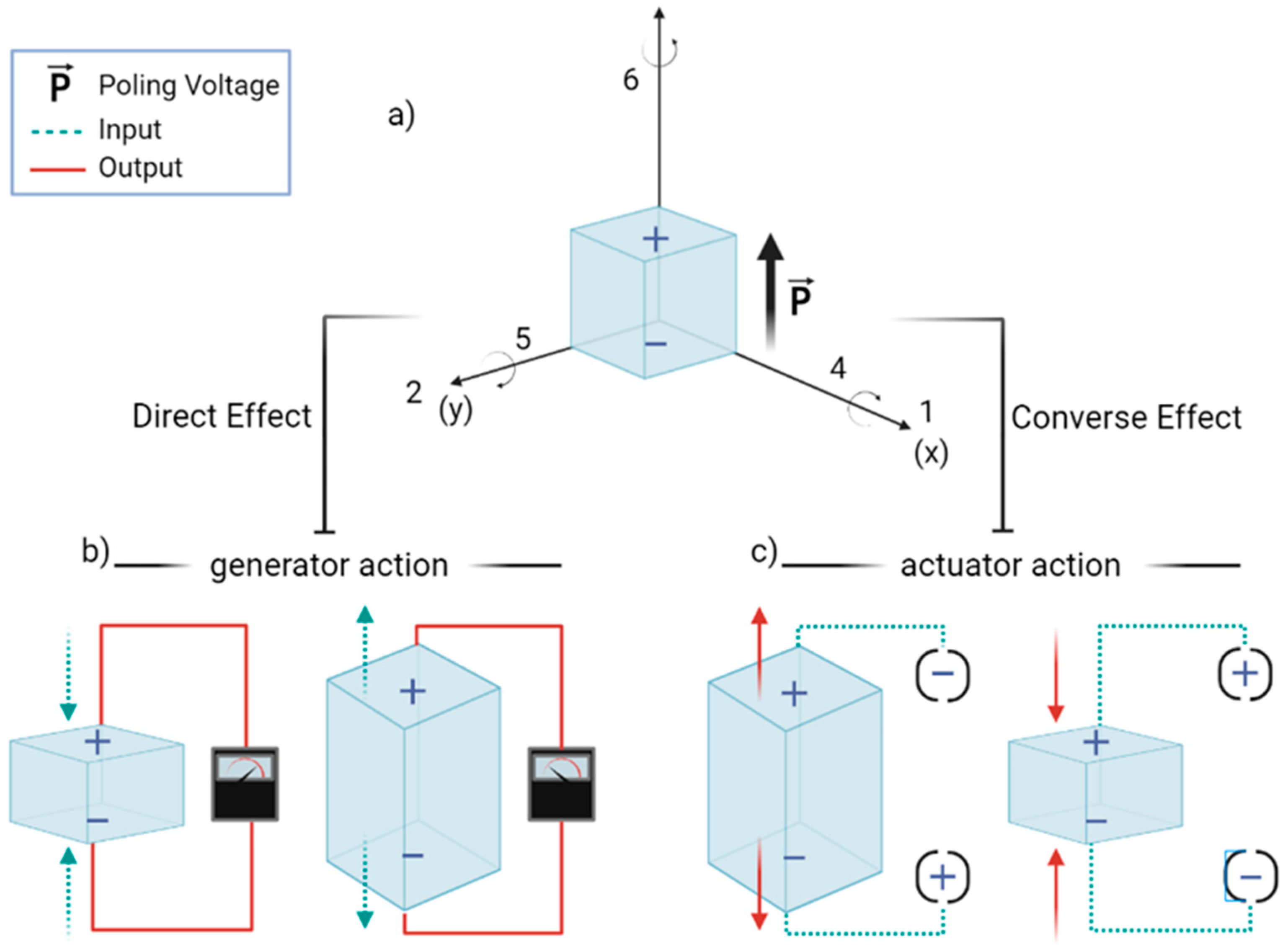


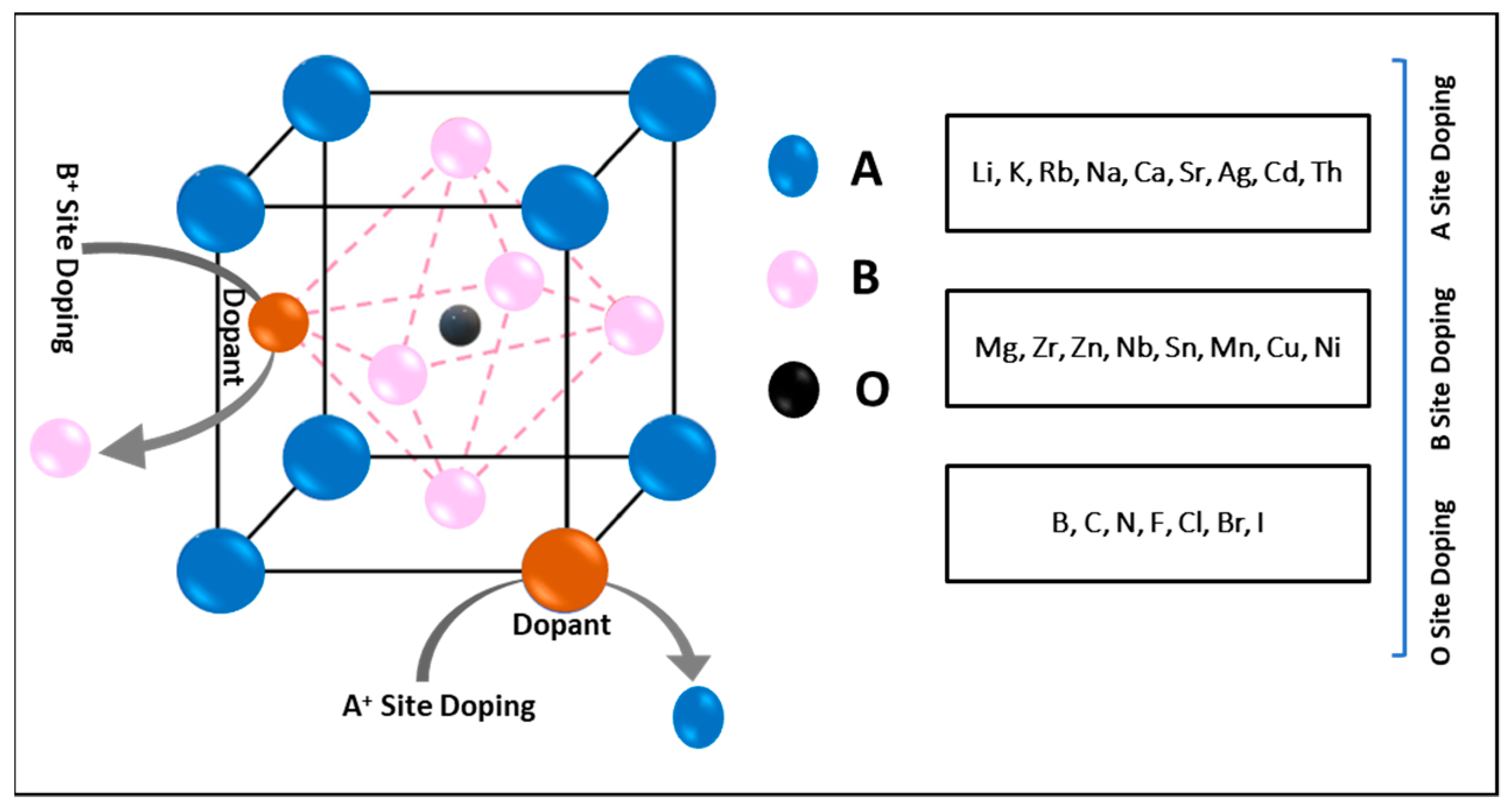

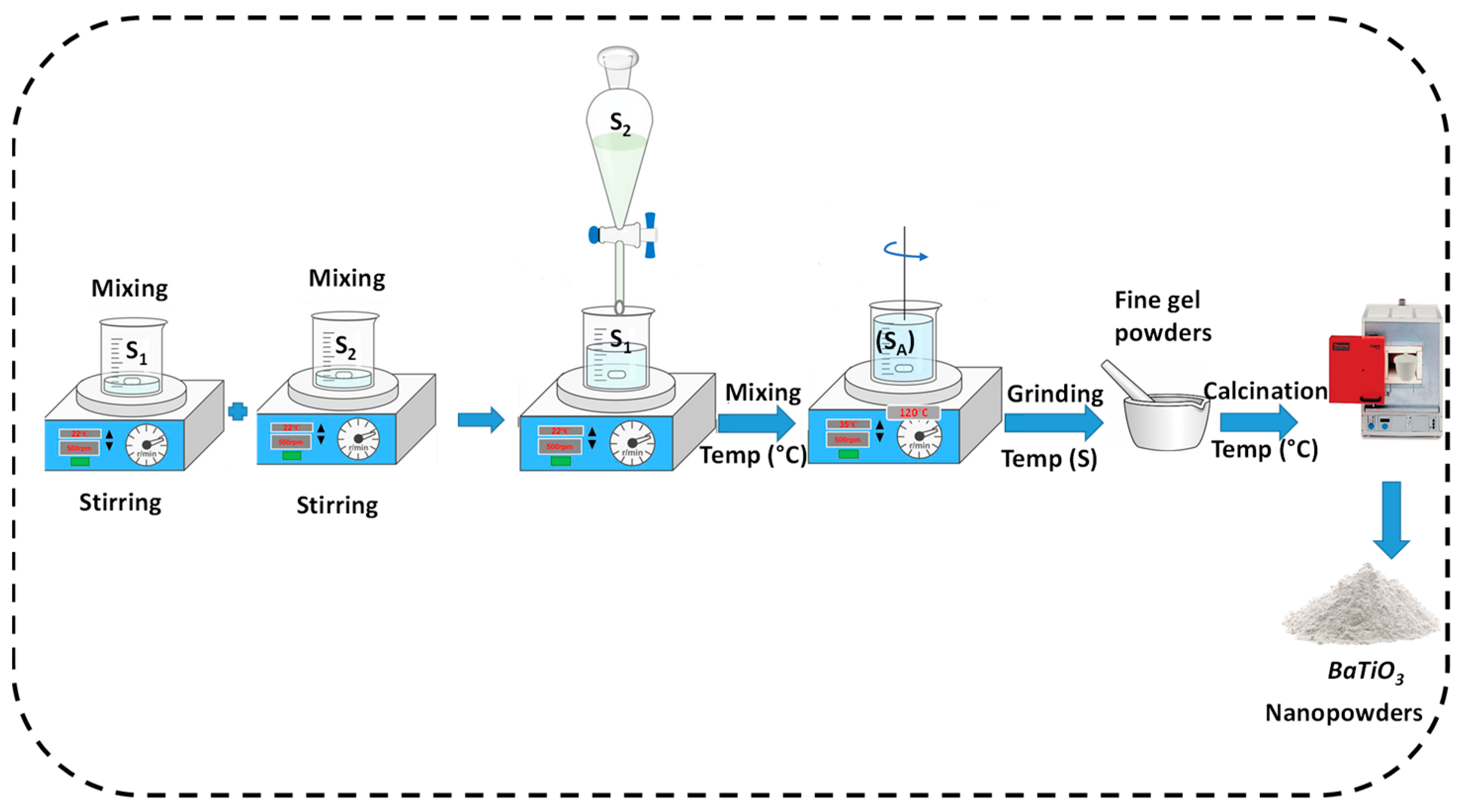

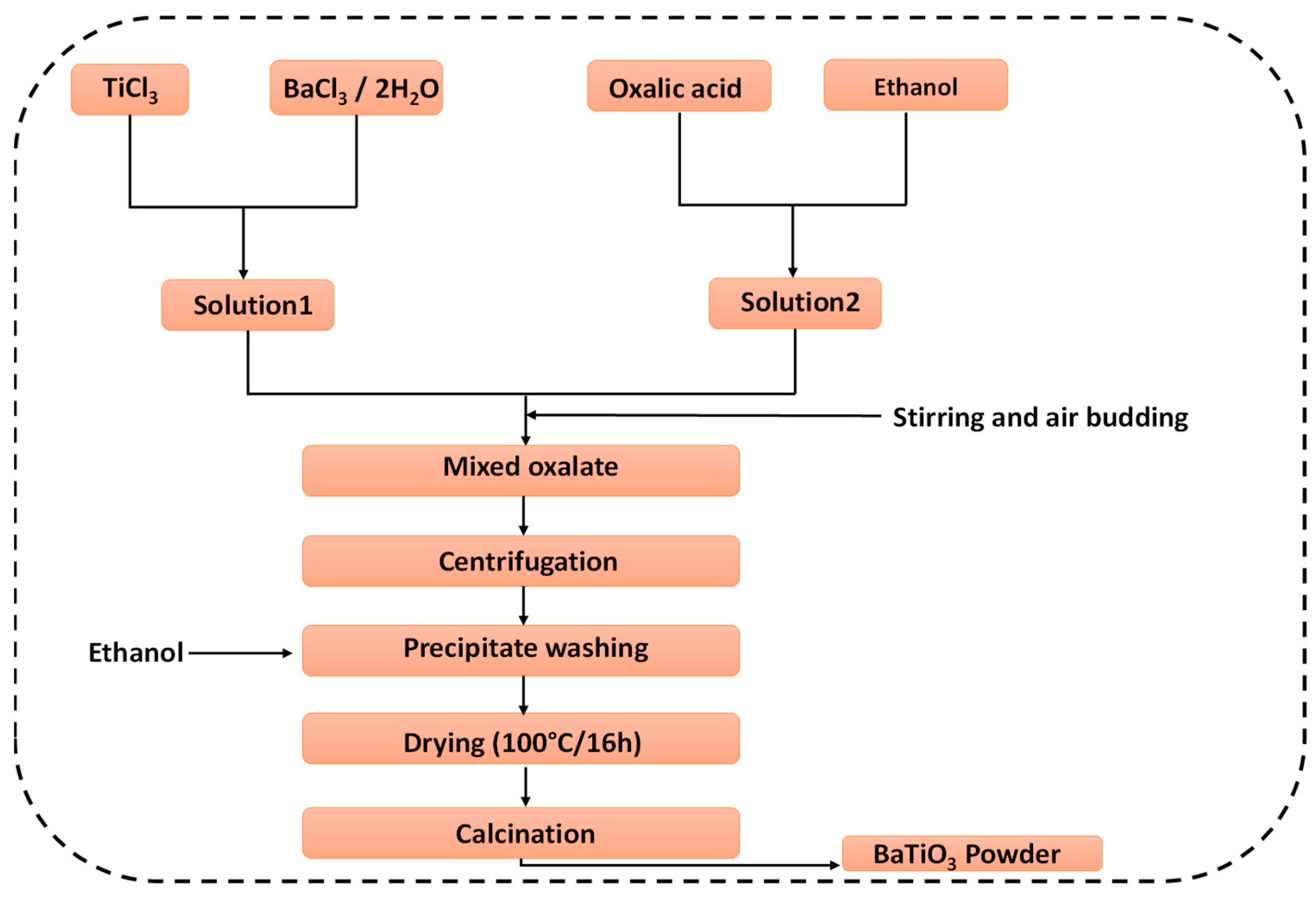

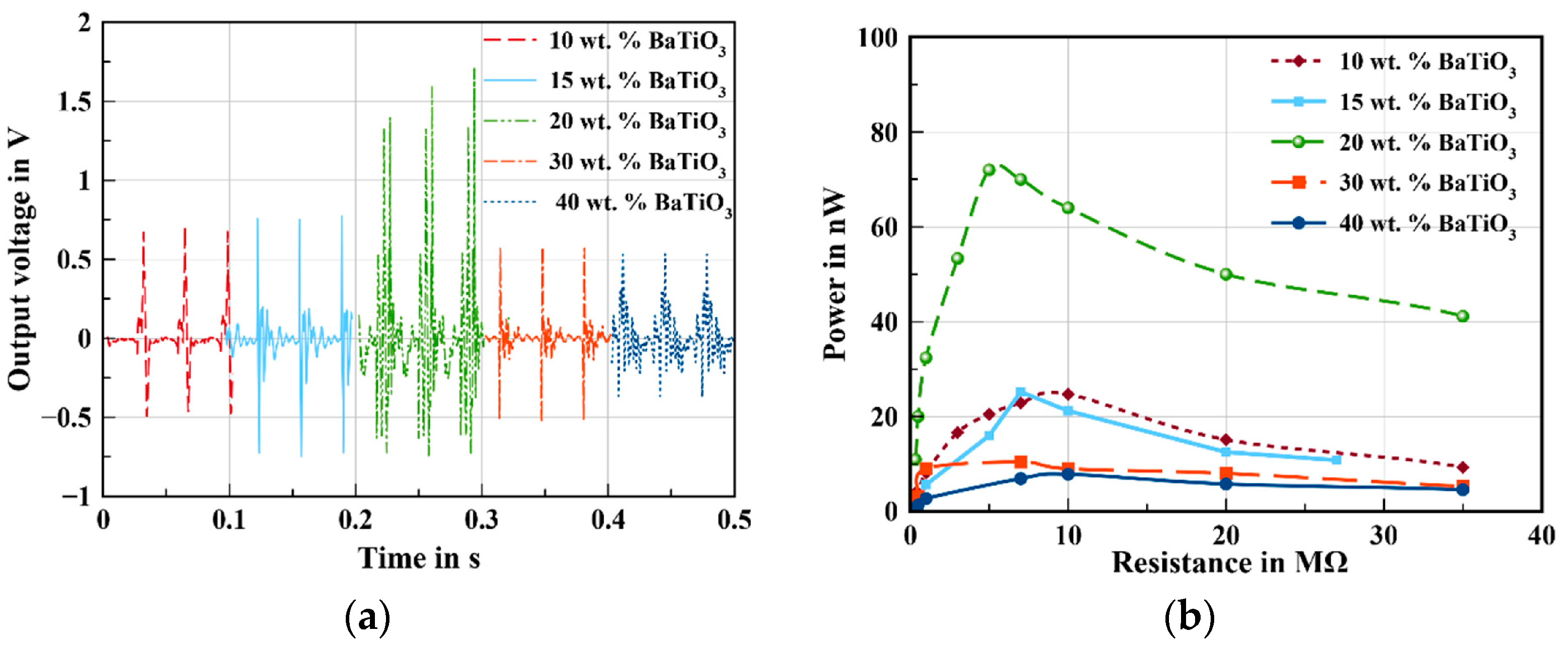


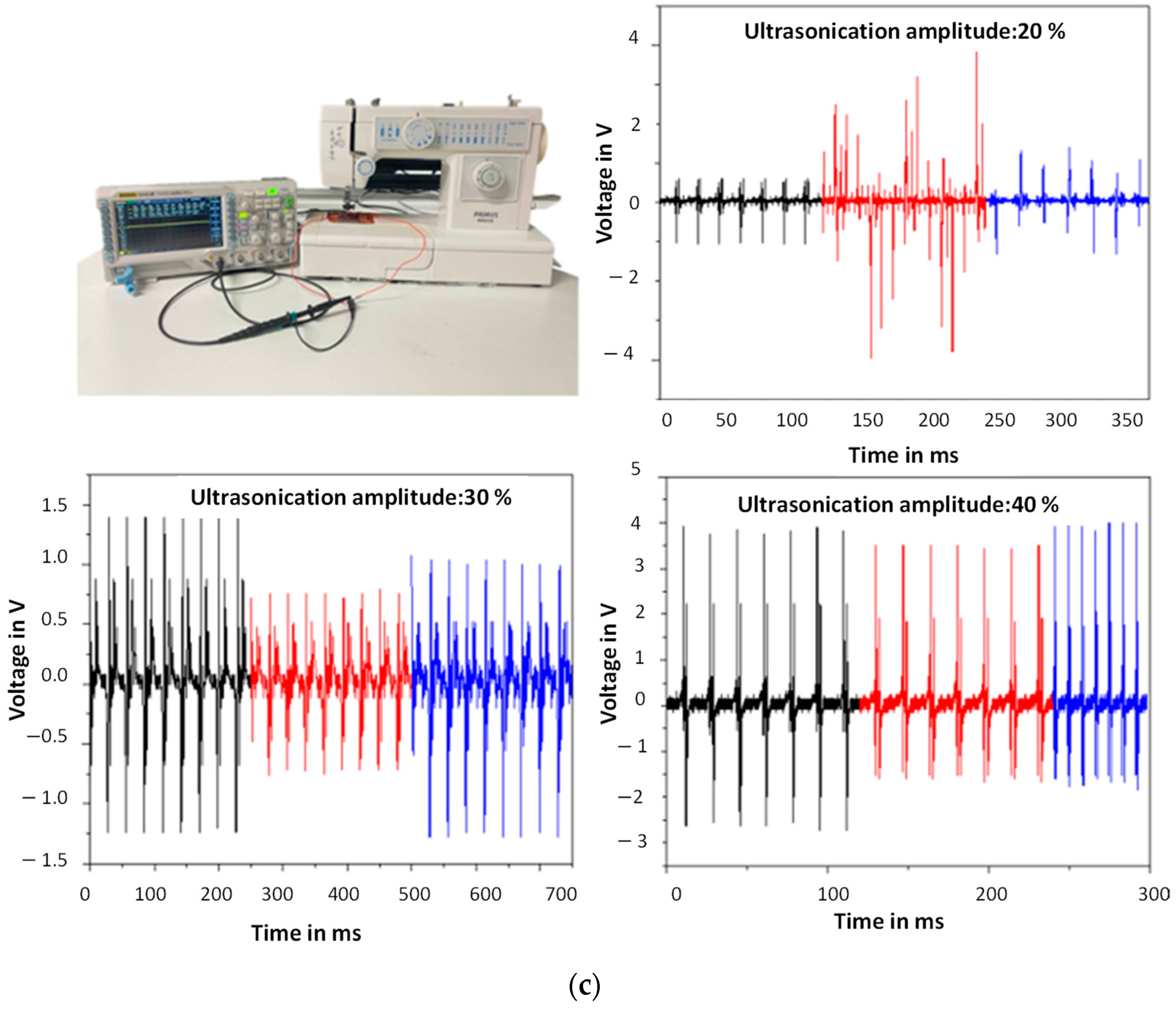
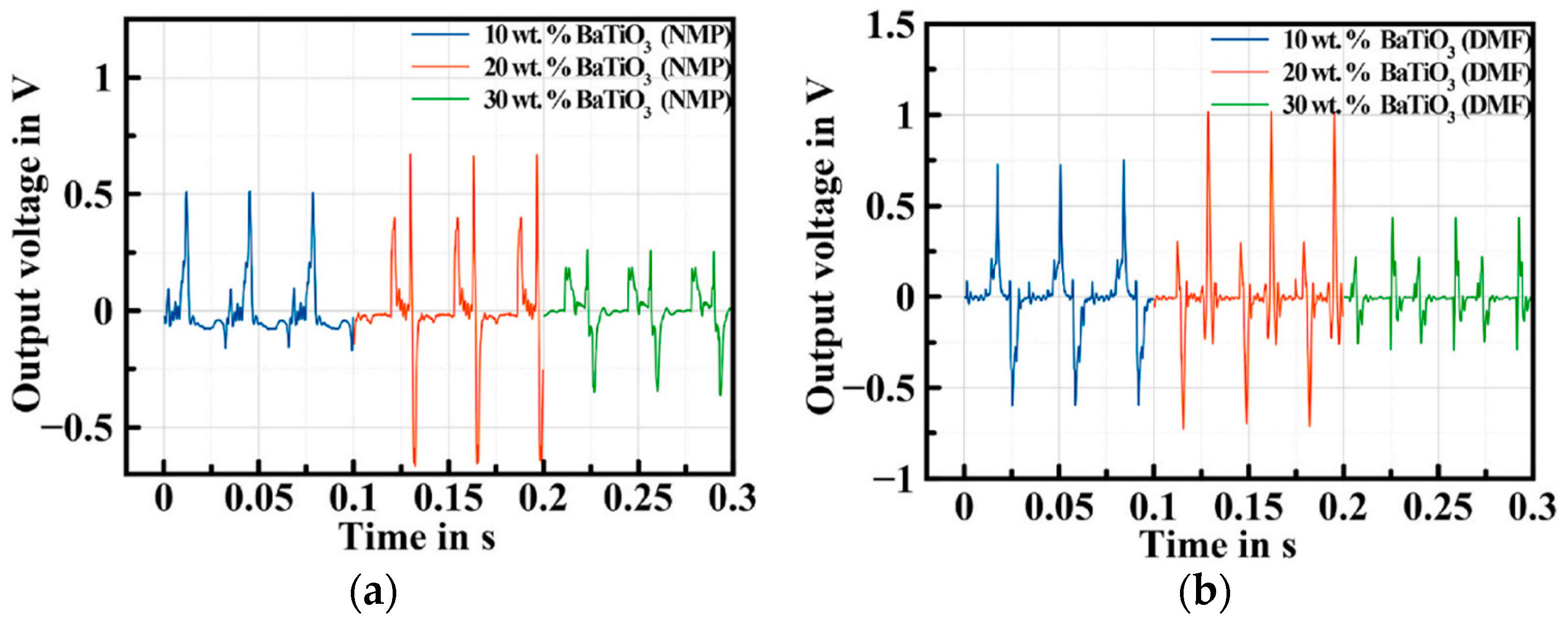


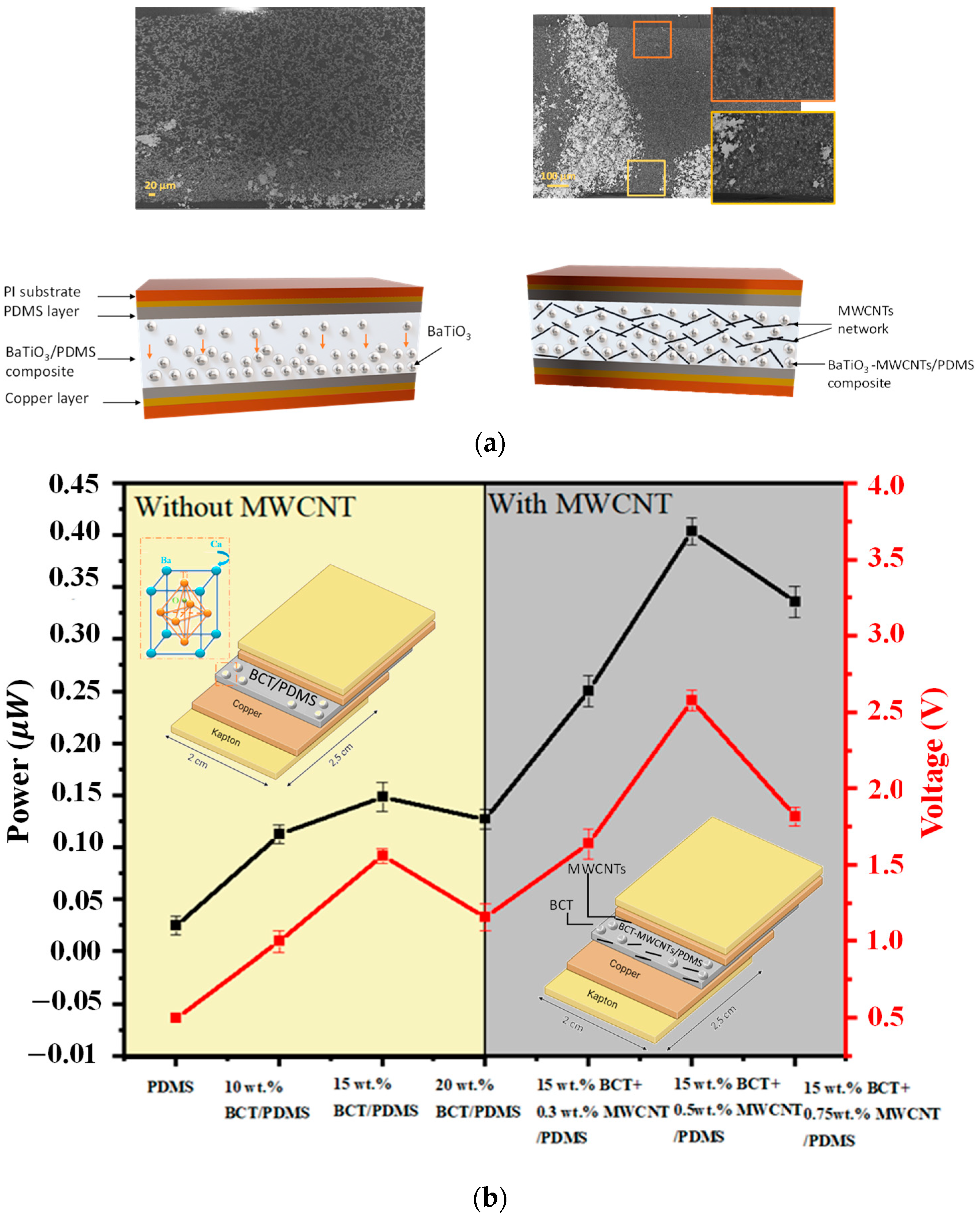

| Systems | Type of System | Tc (C) | d33 (pC/N) | Kp | Ref. |
|---|---|---|---|---|---|
| KNN | Lead ceramic | - | 391 | - | [35] |
| PbNb2O6 | Lead ceramic | - | 83 | - | [36] |
| PZT | Lead ceramic | 490 | 611 | - | [37] |
| PbZr0.54Ti0.46O3 | Lead ceramic | - | 588 | - | [38] |
| 0.67PMN-0.33PT | Lead ceramic | 660 | - | - | [39] |
| BaTiO3 | Lead-free ceramic | 130 | 140 | - | [40] |
| Nd-doped Bi4Ti3O12 | Lead-free ceramic | - | 38 | - | [41] |
| BaTiO3 single crystal | Lead-free ceramic | 250 | 80 | - | [42] |
| Li-doped BaTiO3 | Lead-free ceramic | 130 | 260 | 0.4 | [43] |
| Ba1+xTiO3-0.04LiF | 95 | 340 | 0.5 | [44] | |
| Ba (Ti0.96Sn0.04) O3−xY2O3 | Lead-free ceramic | 84.7 | 454 | 0.5 | [45] |
| (1 − x) BaTiO3−xBa (Cu1/3Nb2/3) O3 | Lead-free ceramic | 96 | 333 | 0.4 | [46] |
| BNT | Lead-free ceramic | 500 | 21.5 | - | [47] |
| BNT–BT | Lead-free ceramic | 500 | 21.5 | [47] | |
| BNKT | Lead-free ceramic | 367.15 | 198 | 0.598 | [48] |
| BNT–BZT | Lead-free ceramic | 244 | 168 | 0.27 | [49] |
| ZnO | Lead-free ceramic | - | 44.33 | - | [50] |
| BiFeO3 | Lead-free ceramic | 870 | 140 | - | [51] |
| Synthesis Method | Precursors | Reaction Conditions | Morphologies | Phases | Ref. |
|---|---|---|---|---|---|
| Sol–gel assisted solid-state | BaCO3 and TiO2 |
| Length: 760 nm–1061 nm Diameter: 73 nm–273 nm | Tetragonal | [72] |
| Hydrothermal | butyl titanate and barium chloride dihydrate | 160 °C for 12 h allowing the autoclave to cool before opening | Average diameter: 30 nm Length: 150 nm | Cubic | [73] |
| Hydrothermal | BaCl2·2H2O and TiCl4 | 240 °C for 20 h. | Diameters ranging from 20 to 30 nm and lengths reaching up to >90 nm | Cubic | [74] |
| Hydrothermal | BaCl2 and titanium (IV) butoxide | 200 °C for 24 h | Spherical particles with diameters ranging from 10 to 30 nm | Cubic | [75] |
| Hydrothermal | titanium dioxide (TiO2) and Ba(OH)2 8H2O | Heated to 200 °C followed by a dwell time of 24 h | Nanoparticles average radius: <25 nm | Cubic | [76] |
| Hydrothermal | Ba(OH)2·8H2O and TiO2 | 130 °C for 24 h 130 °C for 48 h 130 °C for 72 h 100 °C for 48 h 150 °C for 48 h 180 °C for 48 h | Nano-cubic barium titanate: 20–500 nm | Cubic | [77] |
| Sol–gel | Ba(CH3CO2)2 and titanium (IV) isopropoxide | The samples were dried at 200 °C for 12 h and annealed at 700 °C or 800 °C for 1 h | Nanocrystallites with average sizes of 20 nm and 15 nm | Pm-3m cubic | [78] |
| Sol–gel | barium hydroxide and tartaric acid | calcining treatment at 650 °C | Powders with a size of 50 nm | Tetragonal | [79] |
| Sol–gel assisted hydrothermal | BaCl2·2 H2O and TiCl4 | 100 °C–250 °C for 3 h | nanoparticles | Cubic to rhombohedra | [80] |
| Solid-state | BaCO3 and TiO2 | 900 °C for 2 h | nanocrystals | - | [81] |
| Solid-state | BaCO3, TiO2, and ZrO2 | 1050 °C for 6 h | Powders < 0.5 m | - | [82] |
| Nanoparticles | Polymer | Output Voltage (V) | Applied Force | Application | Ref |
|---|---|---|---|---|---|
| 0.82Ba(Ti0.89Sn0.11)O3–0.18(Ba0.7Ca0.3)TiO3 | PDMS | 39 | Vertical force of 35 N at 2 Hz | Tactile imitation | [86] |
| BaTiO3 | PDMS | 7 | - | [87] | |
| BaTiO3 | PDMS | 10.6 | - | [88] | |
| BaTiO3 | PVDF | 7.99 | - | [89] | |
| Ba0.85Ca0.15Ti0.9Zr0.1O3 | PVDF-HFP | 4.5 1.8 | Foot motion, mechanical excitation using an electromechanical shaker | [90] |
Disclaimer/Publisher’s Note: The statements, opinions and data contained in all publications are solely those of the individual author(s) and contributor(s) and not of MDPI and/or the editor(s). MDPI and/or the editor(s) disclaim responsibility for any injury to people or property resulting from any ideas, methods, instructions or products referred to in the content. |
© 2024 by the authors. Licensee MDPI, Basel, Switzerland. This article is an open access article distributed under the terms and conditions of the Creative Commons Attribution (CC BY) license (https://creativecommons.org/licenses/by/4.0/).
Share and Cite
Bouhamed, A.; Missaoui, S.; Ben Ayed, A.; Attaoui, A.; Missaoui, D.; Jeder, K.; Guesmi, N.; Njeh, A.; Khemakhem, H.; Kanoun, O. A Comprehensive Review of Strategies toward Efficient Flexible Piezoelectric Polymer Composites Based on BaTiO3 for Next-Generation Energy Harvesting. Energies 2024, 17, 4066. https://doi.org/10.3390/en17164066
Bouhamed A, Missaoui S, Ben Ayed A, Attaoui A, Missaoui D, Jeder K, Guesmi N, Njeh A, Khemakhem H, Kanoun O. A Comprehensive Review of Strategies toward Efficient Flexible Piezoelectric Polymer Composites Based on BaTiO3 for Next-Generation Energy Harvesting. Energies. 2024; 17(16):4066. https://doi.org/10.3390/en17164066
Chicago/Turabian StyleBouhamed, Ayda, Sarra Missaoui, Amina Ben Ayed, Ahmed Attaoui, Dalel Missaoui, Khawla Jeder, Nesrine Guesmi, Anouar Njeh, Hamadi Khemakhem, and Olfa Kanoun. 2024. "A Comprehensive Review of Strategies toward Efficient Flexible Piezoelectric Polymer Composites Based on BaTiO3 for Next-Generation Energy Harvesting" Energies 17, no. 16: 4066. https://doi.org/10.3390/en17164066








